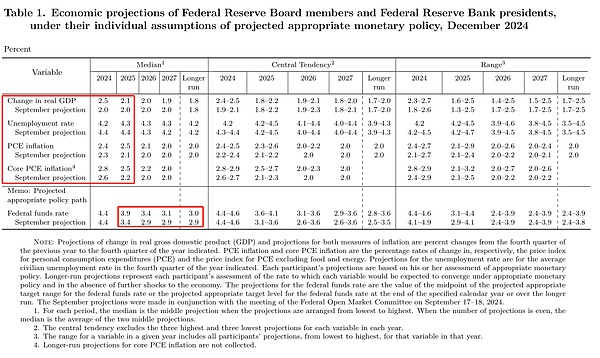
Source: Zhibao Investment Research
SummaryAt this meeting, the Federal Reserve cut interest rates by 25bp to 4.25%-4.5%, in line with expectations. The overnight reverse repurchase facility was technically adjusted to the lower edge of the federal funds rate range.
The wording of the meeting statement has been adjusted, reflecting the changes in the "tempo" and "amplitude" of the FOMC's consideration of subsequent implementation. There were also differences in vote types, with some members opposing an interest rate cut in December.
Economic forecasts clearly reflect concerns about inflation risks, and the Fed's risk balance is clearly tilted towards inflation again. The dot plot only hints at two rate cuts next year, showing a decidedly hawkish bias.
In the opening remarks of the press conference, Powell mentioned the "more neutral setting" and the "Cautious" for further interest rate cuts, expressing a hawkish stance.
The U.S. dollar/VIX surged, and U.S. bonds, U.S. stocks, gold, and Bitcoin fell sharply.
Statement (changes in bold)Recent indicators suggest that economic activity has continued to expand at a solid pace. Since earlier in the year, labor market conditions have generally eased, and the unemployment rate has moved up but remains low. Inflation has made progress toward the Committee's 2 percent objective but remains somewhat elevated.
Recent indicators suggest that economic activity continues to expand at a solid pace. Labor market conditions have generally eased since the beginning of the year, with the unemployment rate rising but remaining at low levels. Inflation has moved toward the committee's 2% target, but is still slightly high.
The Committee seeks to achieve maximum employment and inflation at the rate of 2 percent over the longer run. The Committee judges that the risks to achieving its employment and inflation goals are roughly in balance. The economic outlook is uncertain, and the Committee is attentive to the risks to both sides of its dual mandate.
The Committee seeks to achieve its full employment and 2% inflation goals over the longer term. The Committee judges that the risks to achieving its employment and inflation objectives are broadly balanced. The economic outlook is uncertain, and the Committee is concerned about the risks on both sides of its dual mission.
In support of its goals, the Committee decided to lower the target range for the federal funds rate by 1/4 percentage point to 4-1/4 to 4-1/2 percent. In considering the extent and timing of additional adjustments to the target range for the federal funds rate, the Committee will carefully assess incoming data, the evolving outlook, and the balance of risks. The Committee will continue reducing its holdings of Treasury securities and agency debt and agency mortgage‑ backed securities. The Committee is strongly committed to supporting maximum employment and returning inflation to its 2 percent objective.
To support its objective, the Committee decided to lower the federal funds rate target range by 25bp to 4.25% to 4.5%. In considering the magnitude and timing of further adjustments to the target range for the federal funds rate, the Committee will carefully evaluate newly received data, the evolving outlook, and the balance of risks. The Committee will continue to reduce its holdings of Treasury securities, agency debt, and agency mortgage-backed securities. The Committee remains firmly committed to supporting maximum employment and returning inflation to its 2 percent objective.
In assessing the appropriate stance of moneyary policy, the Committee will continue to monitor the implications of incoming information for the economic outlook. The Committee would be prepared to adjust the stance of monetary policy as appropriate if risks emerge that could impede the attainment of the Committee's goals. The Committee's assessments will take into account a wide range of information, including readings on labor market conditions, inflation pressures and inflation expectations, and financial and international developments.
When evaluating currencies The Committee will continue to monitor the impact of the information received on the economic outlook as appropriate. The Committee will be prepared to adjust its monetary stance as appropriate if risks arise that may impede the achievement of the Committee's objectives. The Committee's assessment will consider a wide range of information, including its interpretation of labor market conditions, inflationary pressures and inflation expectations, and financial and international developments.
Voting for the monetary policy action were Jerome H. Powell, Chair; John C. Williams, Vice Chair; Thomas I. Barkin; Michael S. Barr; Raphael W. Bostic; Michelle W. Bowman; Lisa D. Cook; Mary C. Daly; Philip N. Jefferson; Adriana D. Kugler; and Christopher J. Waller. Voting against the action was Beth M. Hammack, who preferred to maintain the target range for the federal funds rate at 4-1/2 to 4-3/4 percent.
Votes in favor of monetary action were: Chairman Jerome Powell, Vice Chairman John Williams, Thomas Barkin, Michael Barr, Raphael Bostic, Michelle Bowman, Lisa Cook, Mary Daly, Philip Jefferson, Adrianna Kugler and Christopher Waller . Beth M. Hammack voted against, preferring to maintain the target range for the federal funds rate at 4.5% to 4.75%.
Economic forecasts and dot plotsThe economic forecast for 24/25 is raised, the unemployment rate forecast is lowered, and the inflation forecast is raised. The inflation forecast for 25 years is raised by a larger margin.
The dot plot only guides two interest rate cuts throughout next year, showing a strong hawkish tendency.
Q&A session
Mi Xiu did not attend the entire meeting due to illness. Following the press conference, specific questions and answers are still to be sorted out after the official documents are released.














